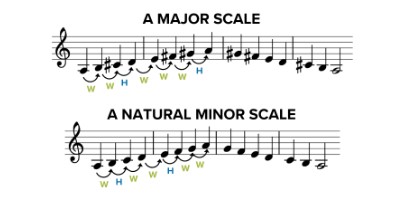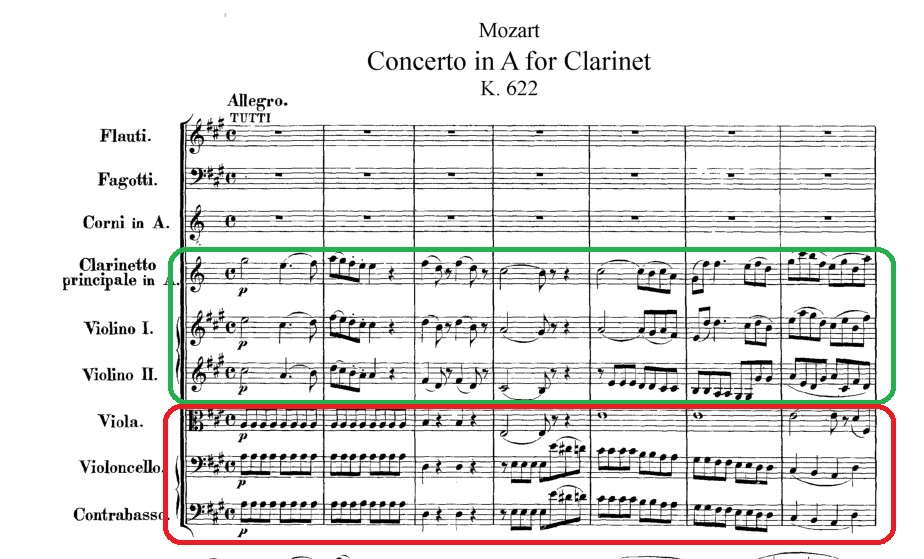Introduction
We love to listen to different kinds of music and be moved by the emotions in different music pieces. Listeners have various preferences in the styles of moods in music. For example, some people love music with enthusiasm while others love music with gentleness and warmth. So, how do the composers put their emotions in music and express the emotions by creating different songs? This article will talk about one of the musical strategies called modes that composers use to express their emotions, especially in classical music.
The definition of musical mode
Composers often use different modes in their works. Modes are variations in scales, one of the fundamental elements of music ( Tom Morello, 2019).
A mode is simply the scale pattern that can begin on any note in the scale (Tom Morello, 2019). Therefore, the mode of music is only related to the distance between notes instead of the actual pitches in the song.
For example, the pictures below use A major and A minor as an example to show the structure of basic modes. We can see the different positions of the halftones represented by ‘H’ and the whole tones represented by ‘W’.

Musical modes play an important role in deciding the basic mood of the music by their differences in structure. There are many theories about why people can feel emotions by different modes, such as a theory related to the dissonance of keys in different kinds of modes, the uncertainty in the tonic of different scales, and so on (Richard Parncutt, 2014). Although musicians have not found a certain explanation for why the musical modes can tell types of emotions directly to people, undoubtedly, we still have the ability to correctly feel the emotions based on different modes. For example, the listeners would not recognize Beethoven’s “Ode to Joy” as a depressing song even if they did not recognize the different modes.
Research on modes by their main melody
Most of the listeners can easily recognize the main melody of the song that contains the basic pitches of its mode scale. For example, the record below shows the beginning of Mozart’s Clarinet Concerto in A major, and the picture shows what notes the whole orchestra plays in this beginning part. The main melody of this part is marked with a green box, while the accompaniment part is in a red box in the picture.

From these pieces of evidence above, we can find that people pay more attention to the main melody instead of the harmonies in the accompaniment part. So, what emotions are contained in the mode scales of the main melody?
Major
Although the emotions represented by different kinds of major modes have a little difference, we can obviously feel the positive emotion from the main melody of the song. Major scales are usually considered to convey a positive sense of brightness, excitement, martial causes, happiness and joy (Dale Purves, n.d.).
There are many examples that can prove this idea, such as Bizet’s Carmen Overturn, Beethoven’s Symphony No. 7, and Mozart’s Symphony No. 41 ‘Jupiter’.
The record below shows Bizet’s Carmen Overturn. In this composition, Bizet used bright A major and F major to describe the enthusiastic atmosphere in the bullring and the energetic hero of this opera.
Minor
Just like the major, different kinds of minor modes also have some differences in emotions. As a whole, minor scales typically evoke negative feelings like sadness, depression, and tragedy ( Michael Hahn,2019).
There are many symphonies with minor scales that can prove this point, for example, Rachmaninov’s Symphony No. 2, Mahler’s Symphony No.2, and Schumann’s Piano Concerto in A minor.
The video of Mahler’s Symphony No.2: https://www.youtube.com/watch?v=udhHFt–10Q
Mahler used C minor as the dominant mode scale in the composition. The first movement of this composition is called Funeral. The whole movement is immersed in a depressed emotion.
Gregorian mode
There is also a mode system that is different from major and minor, and it’s called the Gregorian mode. It contains eight different modes: Dorian, Phrygian, Lydian, Mixolydian, Hypodorian, Hypophrygian, Hypolydian, and Hypomixolydian (Classic FM, 2018).
The picture below shows the structure of different Gregorian modes:

These modes can also represent different kinds of emotions. Usually, the modes Dorian and Hypodorian impart a sense of solemnity or gravity, the modes Phrygian and Hypophrygian are the mysterious, modes 5 and 6 are the peaceful ones, and modes 7 and 8 are the joyful ones (ClergetKubisz, 2016).
Research on modes by their chords
Aside from the main melodies in compositions, there is also an important element called chords, which are used to accompany melodies and construct emotional atmospheres. Chord, in music, is any harmonic set of pitches consisting of multiple notes (Wikipedia, n.d.). Various kinds of chords can represent different kinds of feelings in classical music.
The picture below shows the beginning of Claude Debussy‘s Première Arabesque. The chords in the accompaniment part are in a red box.

Triads
A triad is a kind of chord containing a set of three notes that can be stacked vertically in thirds (Wikipedia,n.d.). There are four kinds of triads that often create different kinds of emotions in compositions. They are the major triad, the minor triad, the diminished triad, and the augmented triad. Each of them sounds various and can give listeners different kinds of feelings. The distance between each note in a triad decides its category, and musicians can make different types of triads in every pitch according to the structure of the triad. The picture below shows the structure of these four triads.

Four kinds of triads can represent different feelings for listeners. Major chords are generally perceived as positive, and minor chords are often negative (David Radford Bakker & Frances Heritage Martin, 2014). For the remaining two triads, the diminished triad and the augmented triad can all bring a kind of disruption and an unexpected feeling to listeners. Diminished triads are often gloomy and depressing, while augmented triads are often annoying and shocking.
Seventh chord
A seventh chord is a kind of chord containing a set of four notes. It contains a triad as its base and pluses an extra note as the seventh note in this chord (Wikipedia, n.d.). Its types are also related to their structure instead of what accurate pitches are contained in them. The picture below shows the five basic types of seventh chords and their structures.

Seventh chords can give listeners more complicated and intensive emotions to listeners than triads can because of its complex structure. It is hard to summarize the emotion in seventh chords to some simple words, but as usual, major seventh chords are often positive, while minor seventh chords are negative just as triads (Soundfly team, 2018). For the dominant seventh, it sounds like a major seventh without enough stability so that people can be attracted by this unpredictability. The diminished seventh and half-diminished seventh often show negative feelings like frustration, depression, and fear.
Main chords in various modes
Different mode scales contain different kinds of main chords to create the basic emotion of the composition. The chord made of Ⅰ.Ⅲ.Ⅴ is the main chord of a mode scale while the chords begin at Ⅰ.Ⅳ.Ⅴ.Ⅶ are often the most representative dominant chord that can show the feature of a mode scale. The picture below shows the triads in C harmonic minor (the most common type of minor) and C major. All the aforementioned chords are boxed in red. According to the structure of musical interval (a theory used to count the distance between pitches), we can figure out the categories of different kinds of chords. The different categories of triads are circled by different colors. Major triads are in green boxes, minor triads are in blue boxes while diminished triads are in red boxes.

From the picture below, we can find that there are more minor triads in chords inⅠ.Ⅳ.Ⅴ.Ⅶ in minor scales than major scales. On the contrary, there are more major triads I in major scales. We have known the positive feeling that major triads represent and the negative feeling that minor triads represent. So, this may explain how musical chords show their functions and help to create different atmospheres in different mode scales.
In conclusion, composers cannot only arrange the notes in different mode scales horizontally to express emotions by melodies but also arrange the notes vertically to construct emotional atmospheres by making chords.
Reference list
Tom Morello, 2019. What Are Musical Modes. [assessed 20 August, 2020]. Available from: https://www.masterclass.com/articles/what-are-musical-modes
Dale Purves, n.d. Emotions Elicited by Major versus Minor Scales. [assessed 21 August, 2020] Available from: https://www.coursera.org/lecture/music-as-biology/emotions-elicited-by-major-versus-minor-scales-mXpMI
Richard Parncutt, 2014. The emotional connotations of major versus minor tonality: One or more origins?[assessed 21 August, 2020]. Available from: https://journals.sagepub.com/doi/10.1177/1029864914542842
musicnotes NOW, n.d. diatonic scales. [electronic picture] Available at: www.musicnotes.com/now/musictheory/the-3-types-of-minor-scales-in-music/
Anon, 2013. The music sheet of Mozart Concerto in A for Clarinet. [electronic picture]. Available at: http://www.doc88.com/p-019966379687.html
W.A. Mozart,1791. Clarinet Concerto in A major,K622. (Remastered 2010) [sound recording] Performed by Gervase De Peyer and London Symphony Orchestra.
2020, The piano version of the beginning part of Mozart Clarinet Concerto.
Bizet, 1978. Carmen Overturn. (Remastered 2012) [sound recording] Performed by The Rainbow Orchestra.
classic fM, 2018. Modes: What are they and how do I use them? [assessed 28August 28, 2020] Available from: https://www.classicfm.com/discover-music/latest/guide-to-musical-modes/
Wikipedia, n.d. The eight musical modes. [electronic picture] Available at: https://en.wikipedia.org/wiki/Mode_(music)#CITEREFCurtis1997
ClergetKubisz,2016. Effect of Specific Modes. [assessed 28 August 28, 2020]. Available from: https://forum.musicasacra.com/forum/discussion/13340/effect-of-specific-modes/p1
Wikipedia, n.d. Chord(music). [assessed 30 August 2020]. Available from: https://en.wikipedia.org/wiki/Chord_(music)
Wikipedia, n.d. Claude Debussy‘s Première arabesque. [electronic picture] Available at: https://en.wikipedia.org/wiki/Chord_(music)
Wikipedia, n.d. triad(music). [assessed 5 September 2020]. Available from: https://en.wikipedia.org/wiki/Triad_(music)
Wikipedia, n.d. types of triad. [electronic picture] Available at: https://en.wikipedia.org/wiki/Triad_(music)
David Radford Bakker & Frances Heritage Martin, 2014. Musical chords and emotion: Major and minor triads are processed for emotion. [assessed 5 September 2020. Available from: https://link.springer.com/article/10.3758/s13415-014-0309-4
Open textbooks for Hong Kong, 2019. Common Seventh Chords. [electronic picture] Available at: http://www.opentextbooks.org.hk/ditatopic/2344
Soundfly team, 2018. How to Convey These 8 Emotions Using Chords and Harmony. [assessed 6 September 2020]. Available from: https://flypaper.soundfly.com/write/convey-8-emotions-using-chords-harmony/
Stack Exchange Network, 2020. Triads in Music Theory. [electronic picture]. Available at: https://www.google.com/url?sa=i&url=https%3A%2F%2Fmusic.stackexchange.com%2Fquestions%2F47802%2Ftriads-in-music-theory&psig=AOvVaw3VfmiERzfwmuUotKEWHU6_&ust=1599466531835000&source=images&cd=vfe&ved=0CAkQjhxqFwoTCPipoLmL1OsCFQAAAAAdAAAAABAK
